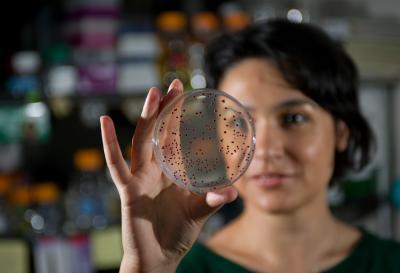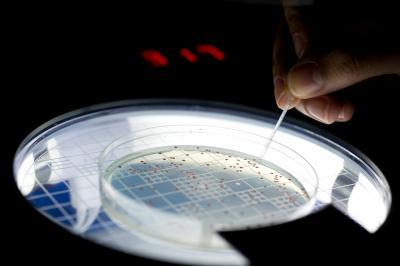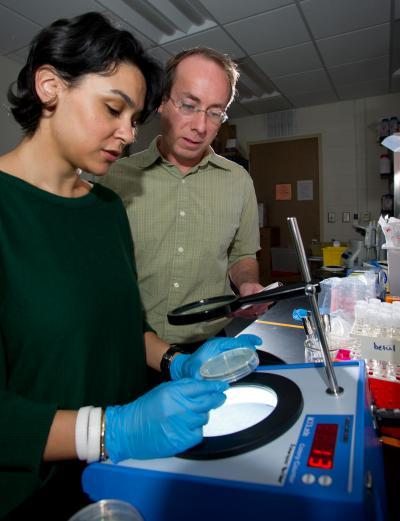It's a project 500 million years in the making. Only this time, instead of playing on a movie screen in Jurassic Park, it's happening in a lab at the Georgia Institute of Technology.
Using a process called paleo-experimental evolution, Georgia Tech researchers have resurrected a 500-million-year-old gene from bacteria and inserted it into modern-day Escherichia coli(E. coli) bacteria. This bacterium has now been growing for more than 1,000 generations, giving the scientists a front row seat to observe evolution in action.
"This is as close as we can get to rewinding and replaying the molecular tape of life," said scientist Betül Kaçar, a NASA astrobiology postdoctoral fellow in Georgia Tech's NASA Center for Ribosomal Origins and Evolution. "The ability to observe an ancient gene in a modern organism as it evolves within a modern cell allows us to see whether the evolutionary trajectory once taken will repeat itself or whether a life will adapt following a different path."

Postdoctoral Fellow Betül Kaçar and Associate Professor Eric Gaucher are watching evolution in action resurrecting a 500-million-year-old gene from bacteria and inserted it into modern-day Escherichia coli (E. coli) bacteria.
(Photo Credit: Georgia Institute of Technology)
In 2008, Kaçar's postdoctoral advisor, Associate Professor of Biology Eric Gaucher, successfully determined the ancient genetic sequence of Elongation Factor-Tu (EF-Tu), an essential protein in E. coli. EFs are one of the most abundant proteins in bacteria, found in all known cellular life and required for bacteria to survive. That vital role made it a perfect protein for the scientists to answer questions about evolution.
After achieving the difficult task of placing the ancient gene in the correct chromosomal order and position in place of the modern gene within E. coli, Kaçar produced eight identical bacterial strains and allowed "ancient life" to re-evolve. This chimeric bacteria composed of both modern and ancient genes survived, but grew about two times slower than its counterpart composed of only modern genes.
"The altered organism wasn't as healthy or fit as its modern-day version, at least initially," said Gaucher, "and this created a perfect scenario that would allow the altered organism to adapt and become more fit as it accumulated mutations with each passing day."

Using a process called paleo-experimental evolution, Georgia Tech researchers have resurrected a 500-million-year-old gene from bacteria and inserted it into modern-day Escherichia coli (E. coli) bacteria. This bacterium has now been growing for more than 1,000 generations, giving the scientists a front row seat to observe evolution in action.
(Photo Credit: Georgia Institute of Technology)
The growth rate eventually increased and, after the first 500 generations, the scientists sequenced the genomes of all eight lineages to determine how the bacteria adapted. Not only did the fitness levels increase to nearly modern-day levels, but also some of the altered lineages actually became healthier than their modern counterpart.
When the researchers looked closer, they noticed that every EF-Tu gene did not accumulate mutations. Instead, the modern proteins that interact with the ancient EF-Tu inside of the bacteria had mutated and these mutations were responsible for the rapid adaptation that increased the bacteria's fitness. In short, the ancient gene has not yet mutated to become more similar to its modern form, but rather, the bacteria found a new evolutionary trajectory to adapt.
These results were presented at the recent NASA International Astrobiology Science Conference. The scientists will continue to study new generations, waiting to see if the protein will follow its historical path or whether it will adopt via a novel path altogether.
"We think that this process will allow us to address several longstanding questions in evolutionary and molecular biology," said Kaçar. "Among them, we want to know if an organism's history limits its future and if evolution always leads to a single, defined point or whether evolution has multiple solutions to a given problem."

Postdoctoral Fellow Betül Kaçar and Associate Professor Eric Gaucher are watching evolution in action resurrecting a 500-million-year-old gene from bacteria and inserted it into modern-day Escherichia coli (E. coli) bacteria.
(Photo Credit: Georgia Institute of Technology)
Source: Georgia Institute of Technology